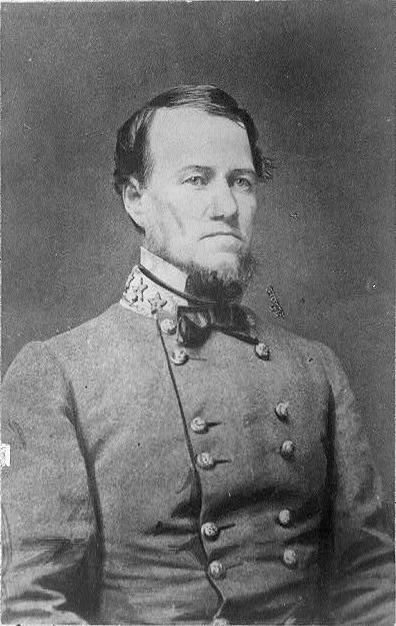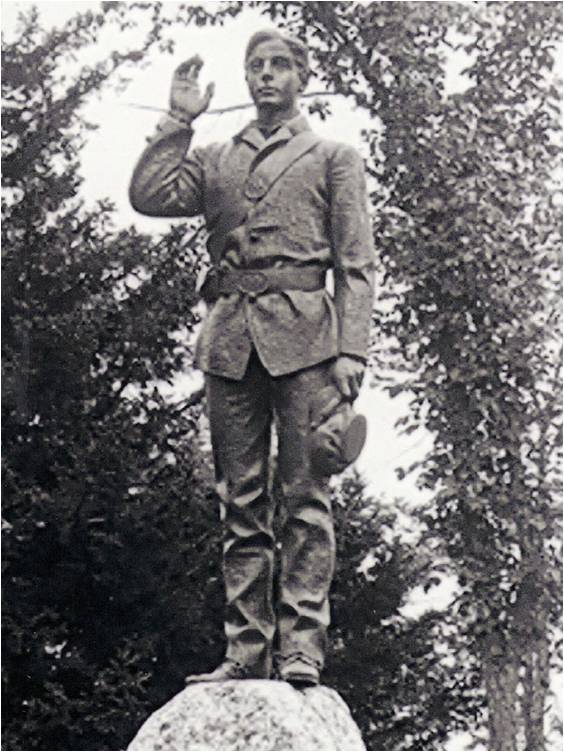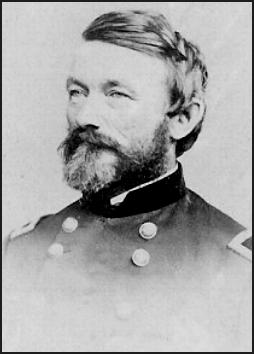|
Battle Of Appomattox Station
The Battle of Appomattox Station was fought between a Union Army (Army of the Potomac, Army of the James, Army of the Shenandoah) cavalry division under the command of Brigadier General (Brevet Major General) George Armstrong Custer and Confederate Army of Northern Virginia artillery units commanded by Brigadier General Lindsay Walker with support from some dismounted cavalrymen, artillerymen armed with muskets and some stragglers on April 8, 1865, at Appomattox Station, Virginia during the Appomattox Campaign of the American Civil War. Following the withdrawal of General Robert E. Lee's Army of Northern Virginia from their defenses at Petersburg, Virginia after the Battle of Five Forks, Third Battle of Petersburg and Battle of Sutherland's Station, the Union Army closely pursued the Confederates westward on parallel and trailing routes. The Confederates, short of rations and supplies, suffered numerous losses from desertion, straggling and battle, especially the Battle of ... [...More Info...] [...Related Items...] OR: [Wikipedia] [Google] [Baidu] |
American Civil War
The American Civil War (April 12, 1861 – May 26, 1865; also known by other names) was a civil war in the United States. It was fought between the Union ("the North") and the Confederacy ("the South"), the latter formed by states that had seceded. The central cause of the war was the dispute over whether slavery would be permitted to expand into the western territories, leading to more slave states, or be prevented from doing so, which was widely believed would place slavery on a course of ultimate extinction. Decades of political controversy over slavery were brought to a head by the victory in the 1860 U.S. presidential election of Abraham Lincoln, who opposed slavery's expansion into the west. An initial seven southern slave states responded to Lincoln's victory by seceding from the United States and, in 1861, forming the Confederacy. The Confederacy seized U.S. forts and other federal assets within their borders. Led by Confederate President Jefferson Davis, ... [...More Info...] [...Related Items...] OR: [Wikipedia] [Google] [Baidu] |
1st West Virginia Volunteer Cavalry Regiment
The 1st West Virginia Cavalry Regiment served in the Union Army during the American Civil War. Although it started slowly, it became one of the most active and effective of the West Virginia Civil War regiments—and had 14 Medal of Honor recipients, the most for any West Virginia regiment during the war. It was originally called the 1st Virginia Cavalry, not to be confused with the Confederate 1st Virginia Cavalry. Some reports added "Union," "Loyal" or "West" when identifying this regiment. After the Unionist state of West Virginia was officially admitted to the Union in 1863, the regiment became the 1st West Virginia Cavalry Regiment. The National Park Service identifies it as the 1st Regiment, West Virginia Cavalry. The regiment was organized in Wheeling, Morgantown and Clarksburg in 1861 and consisted of 13 companies, plus an additional company that was attached for most of the war. Members were predominately recruited from Ohio and Pennsylvania and the western Virginia c ... [...More Info...] [...Related Items...] OR: [Wikipedia] [Google] [Baidu] |
4th North Carolina Infantry
The 4th North Carolina Infantry Regiment was a Confederate States Army regiment during the American Civil War, active from 1861 until the war's end in April 1865. Ordered to Virginia, the unit served in General Winfield S. Featherston’s, George B. Anderson’s, Stephen D. Ramseur’s, and William Ruffin Cox, William R. Cox’s Brigade. Its field officers were Colonels George B. Anderson, Bryan Grimes, Edwin A. Osborne, and James H. Wood; Lieutenant Colonels David M. Carter and John A. Young; and Majors Edward S. Marsh and Absalom K. Simonton. It was nicknamed "The Bloody Fourth" after the high rate of casualties at the Battle of Seven Pines. History The 4th North Carolina regiment was raised in 1861 from central and western North Carolina, with George B. Anderson as its first colonel. The regiment completed its organization in May 1862, at Camp Hill, near Garysburg, North Carolina. It recruited its members in Iredell, Rowan, Wayne, Beaufort, Wilson, and Davie counties. At ... [...More Info...] [...Related Items...] OR: [Wikipedia] [Google] [Baidu] |
12th Virginia Cavalry
The 12th Virginia Cavalry Regiment was a cavalry regiment raised in Virginia for service in the Confederate States Army during the American Civil War. It fought mostly with the Army of Northern Virginia. History Virginia's 12th Cavalry Regiment (originally called 10th Regiment) was organized at Conrad's Store, Virginia, in June 1862, with ten companies from the 7th Virginia Cavalry regiment, which consisted of twenty-nine companies at the time. The unit served in W.E. Jones', Rosser's, and J. Dearing's Brigade, Army of Northern Virginia. It fought in Northern Virginia, in the Maryland Campaign, at Brandy Station, then was involved in various conflicts in the western part of Virginia. The regiment continued the fight at Bristoe and Mine Run, in the battles around The Wilderness and Cold Harbor, and in Early's operations in the Shenandoah Valley. During mid-April, 1865, it disbanded. The field officers were Colonel Asher W. Harman, Lieutenant Colonels Richard H. Burks and Thomas ... [...More Info...] [...Related Items...] OR: [Wikipedia] [Google] [Baidu] |
24th Virginia Infantry
The 24th Virginia Infantry Regiment was an infantry regiment raised in southwestern Virginia for service in the Confederate States Army during the American Civil War. It fought throughout the conflict, mostly with the Army of Northern Virginia. The 24th Virginia's most prominent field officers were Colonels Jubal A. Early (who was promoted to brigade command after the battle and would become a key Confederate General) and William R. Terry; Lieutenant Colonels Peter Hairston, Jr. and Richard L. Maury; and Majors William W. Bentley, Joseph A. Hambrick, and J.P. Hammet. History The 24th Virginia was assembled in Lynchburg in June, 1861, with companies recruited from Floyd, Franklin, Carroll, Giles, Patrick, Pulaski, Mercer, Montgomery County and Henry Counties.Ralph White Gunn, 24th Virginia Infantry (Lynchburg, H.E. Howard Inc. Virginia Regimental History Series, 1st edition 1987) After fighting under former U.S. Army officer and Franklin County delegate Col. Jubal Early at ... [...More Info...] [...Related Items...] OR: [Wikipedia] [Google] [Baidu] |
Army Of Northern Virginia
The Army of Northern Virginia was the primary military force of the Confederate States of America in the Eastern Theater of the American Civil War. It was also the primary command structure of the Department of Northern Virginia. It was most often arrayed against the Union Army of the Potomac. Origin The name ''Army of Northern Virginia'' referred to its primary area of operation, as did most Confederate States Army names. The Army originated as the Army of the Potomac, which was organized on June 20, 1861, from all operational forces in northern Virginia. On July 20 and July 21, the Army of the Shenandoah and forces from the District of Harpers Ferry were added. Units from the Army of the Northwest were merged into the Army of the Potomac between March 14 and May 17, 1862. The Army of the Potomac was renamed ''Army of Northern Virginia'' on March 14. The Army of the Peninsula was merged into it on April 12, 1862.Eicher, pp. 889–90. Robert E. Lee's biographer, Douglas S. ... [...More Info...] [...Related Items...] OR: [Wikipedia] [Google] [Baidu] |
11th Maine Volunteer Infantry Regiment
The 11th Maine Infantry Regiment was an infantry regiment that served in the Union Army during the American Civil War. Service The 11th Maine Infantry was organized in Augusta, Maine, and mustered in for a three-year enlistment on November 12, 1861, under the command of Colonel John Curtis Caldwell. The regiment was attached to Davis' Provisional Brigade, Army of the Potomac, to January 1862. 1st Brigade, Casey's Division, Army of the Potomac, to March 1862. 1st Brigade, 3rd Division, IV Corps, Army of the Potomac, to June 1862. 1st Brigade, 2nd Division, IV Corps, to December 1862. Naglee's Brigade, Department of North Carolina, to January 1863. 2nd Brigade, 2nd Division, XVIII Corps, to February 1863. 1st Brigade, 2nd Division, XVIII Corps, Port Royal, South Carolina, Department of the South, to April 1863. District of Beaufort, South Carolina, X Corps, Department of the South, to June 1863. Fernandina, Florida, Department of the South, to October 1863. 1st Brigade, Morris ... [...More Info...] [...Related Items...] OR: [Wikipedia] [Google] [Baidu] |
1st Maine Volunteer Infantry Regiment
The 1st Maine Infantry Regiment was an infantry regiment that served in the Union Army during the American Civil War. It was later re-activated in 1898 for the Spanish–American War, but did not serve overseas. Service Pre-Civil War In 1847, during the War with Mexico, the President of the United States requested that a regiment of Maine infantry be mobilized for field duty. This was accomplished on paper, but field officers were never assigned and the regiment's companies never trained together. However, this partial mobilization and the influence of the Crimean War of 1853–56 excited military enthusiasm in Maine, and caused new Militia (United States), militia companies to be organized in 1854–56. In 1854 there were 58 companies in the Volunteer Maine Militia, and the request of the companies in and near Portland to be named the 1st Regiment was granted by orders of the Maine state government approved 21 June 1854. General Smith of the 5th Division was ordered to car ... [...More Info...] [...Related Items...] OR: [Wikipedia] [Google] [Baidu] |
199th Pennsylvania Infantry Regiment
The 199th Regiment Pennsylvania Volunteer Infantry, alternately known as the Commercial Regiment, was an infantry regiment of the Union Army in the American Civil War. Raised in Philadelphia in late 1864, the regiment enlisted for one year and was sent to the Army of the James during the Siege of Petersburg. During the Third Battle of Petersburg it assaulted Forts Gregg and Alexander, then pursued the retreating Confederate Army of Northern Virginia, fighting at Rice's Station and Appomattox Court House. Following the Confederate surrender at Appomattox, the regiment moved to Richmond, where it mustered out in late June 1865. History The regiment was organized at Camp Cadwalader near Philadelphia during August, September and October 1864, for a term of one year under the command of staff officer Colonel James C. Briscoe. It was also known as the Commercial Regiment, and many of its soldiers had previously served in other regiments, including Lieutenant Colonel Ambrose A. Lech ... [...More Info...] [...Related Items...] OR: [Wikipedia] [Google] [Baidu] |
87th Pennsylvania Infantry Regiment
The 87th Pennsylvania Volunteer Infantry was an infantry regiment that served in the Union Army during the American Civil War. Service The 87th Pennsylvania Infantry was organized at York, Pennsylvania and mustered in for a three-year enlistment in September 1861 under the command of Colonel George Hay. The regiment was attached to Railroad Guard, Middle Department, to May 1862. Baltimore, Maryland, Middle Department, to June 1862. Railroad Division, VIII Corps, Middle Department, to March 1863. 2nd Brigade, 2nd Division, VIII Corps, Middle Department, to June 1863. 1st Brigade, Elliott's Command, VIII Corps, to July 1863. 3rd Brigade, 3rd Division, III Corps, Army of the Potomac, to March 1864. 1st Brigade, 3rd Division, VI Corps, Army of the Potomac and Army of the Shenandoah, to June 1865. The 87th Pennsylvania Infantry mustered out of service at Alexandria, Virginia, on June 29, 1865. Detailed service Guard duty on Northern Central Railroad from Pennsylvania line to Baltim ... [...More Info...] [...Related Items...] OR: [Wikipedia] [Google] [Baidu] |
39th Illinois Infantry Regiment
The 39th Regiment Illinois Volunteer Infantry, nicknamed "Yates' Phalanx," was an infantry regiment that served in the Union Army during the American Civil War. Service The 39th Illinois Infantry was organized at Chicago, Illinois, and was mustered into service on October 11, 1861, for a three-year term. The regiment was mustered out on December 6, 1865. Adjutant General's Report The organization of this Regiment was commenced as soon as the news of the firing on Fort Sumter reached Chicago. General T. O. Osborn was one of its contemplated field officers, and labored zealously to get it accepted under the first call for troops, but did not accomplish his object. The State having filled its quota without this Regiment, efforts were made to get it accepted into the State service of Missouri, but without success. The Regiment had already assumed the name of His Excellency, the Governor of Illinois, and was known as the "Yates Phalanx". Governor Yates manifested an earnest desire to ... [...More Info...] [...Related Items...] OR: [Wikipedia] [Google] [Baidu] |
67th Ohio Infantry
The 67th Ohio Infantry Regiment was an infantry regiment in the Union Army during the American Civil War. Service The 67th Ohio Infantry Regiment was organized by consolidation of recruits for the 67th Ohio Infantry and 45th Ohio Infantry and mustered in for three years service under the command of Colonel Otto. The regiment was initially armed with outdated Prussian Potsdam muskets, an unpopular weapon that the soldiers considered more dangerous to the shooter than the person being shot at, aside from the flank companies which had Enfield rifles (the Potsdam muskets were replaced with Springfield rifles later that year). Colonel Burstenbinder was even less popular, being described in regimental histories as "an imbecile, imposter, and knave detested by all". He had completely failed to instill even a minimum of training and discipline in the regiment, and on March 12, 1862, he was arrested and court-martialed. Lt. Col Alvin Voris assumed command of the regiment and led it in its ... [...More Info...] [...Related Items...] OR: [Wikipedia] [Google] [Baidu] |






